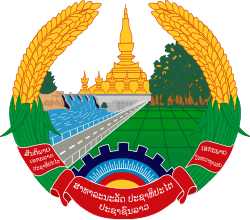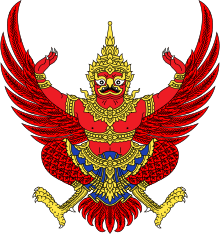Khun Borom
Khun Borom (Thai: ขุนบรม, Thai pronunciation: [kʰǔn bɔːrom]) or Khun Bulom (Lao: ຂຸນບູຮົມ or ຂຸນບູລົມ, Lao pronunciation: [kʰǔn bǔːlóm]) is a legendary progenitor of the Tai-speaking peoples, considered by the Lao to be the father of their race.
Mythology
According to the myth of Khun Borom, commonly related among Tai-speaking peoples, people in ancient times were wicked and crude. A great deity destroyed them with a flood, leaving only three worthy chiefs who were preserved in heaven to be the founders and guides for a new race of people. The deity sent the three chiefs back to the earth with a buffalo to help them till the land.
The chiefs and the buffalo arrived in the legendary land of Muang Then, located at today's Điện Biên Phủ, Vietnam. Once the land had been prepared for rice cultivation, the buffalo died and a bitter gourd vine grew from his nostril. From the gourds on the vine, the new human race emerged—relatively dark-skinned aboriginal peoples emerging from gourds cut open with a hot poker, and the lighter skinned Tai speakers emerging from cuts made with a chisel.
The gods then taught the Tai peoples how to build houses and cultivate rice. They were instructed in proper rituals and behaviour, and grew prosperous. As their population grew, they needed aid in governing their relations and resolving disputes. Indra, the king of the gods, sent his son, Khun Borom, to be the ruler of the Tai people. Khun Borom ruled the Tai people for 25 years, teaching them to use new tools and other arts.
After this quarter-century span, Khun Borom divided the kingdom among his seven sons, giving each one of them a portion of the kingdom to rule.
Alleged association with Nanzhao
Khun Borom is sometimes erroneously identified (apparently without any evidence at all) as having been Piluoge, an historical ruler of the Nanzhao (Ai Lao) Empire. It is claimed that this Khun Borom, ruler of Nanzhao, had nine sons, and seven of them became kings in different kingdoms in "Lamthong":
- "Khun Lo" ruled Moung Sawa (Sua), (Luang Phrabang, Laos)
- "Khun Palanh" ruled Sipsong Panna, (Yunnan, China)
- "Khun Chusong" ruled Tung Kea, (Muang Houaphanh to Tonkin, Vietnam)
- "Khun Saiphong" ruled Yonok Lanna (Thailand)
- "Khun Ngua In" ruled Ayothaya (Thailand)
- "Khun Lok-Khom" ruled Moung Hongsa (Inthaputh), (Shan state, Burma)
- "Khun Chet-Cheang" ruled Moung Phuan, (Xieng Khouang, Laos).
There were 19 kings after Khun Lor who ruled Muang Sawa (Sua). The last one was Khun Vaang, who was then succeeded by:
- Lang, who became King Langthirath
- Thao Khamphong, crowned as King Souvanna Khamphong
- Chao Fifah, also known as Khamhiao, who had six sons
- Chao Fa Ngum, who founded the Lan Xang Kingdom during the 14th century.
Both King Mangrai of Chiang Mai and Uthong of Ayutthaya are said to have been descendants of Khum Borom's younger sons.
Interpretation
Some interpreters of the story of Khun Borom believe that it describes Tai-speaking peoples arriving in Southeast Asia from China (mythically identified with heaven, from which the Tai chiefs emerge after the flood). The system of dividing and expanding a kingdom in order to provide for the sons of a ruler agrees in general with the apparent organization and succession practices of ancient Tai village groups was called mueang.
Scholar David K. Wyatt believes that the Khun Borom myth may provide insight into the early history of the Tai people in Southeast Asia. Versions of the Khun Borom myth occur as early as 698 CE in Siang Khwang, and identify Tai-speaking kingdoms that would be formally established years later. This may indicate the early geographical spread of Tai-speaking peoples, and provides a mythological explanation for why modern Tai-speaking peoples are found in such widespread pockets.
Linguistic analysis indicates that the division of the early Tai speakers into the language groups that gave rise to modern Thai, Lao and other languages occurred sometime between the 7th and 11th centuries CE. This split proceeded along geographic lines very similar to the division given in the Khun Borom legend.
See also
Sources
- Wyatt, David K., Thailand: A Short History, New Haven (Yale University Press), 2003. ISBN 0-300-08475-7

